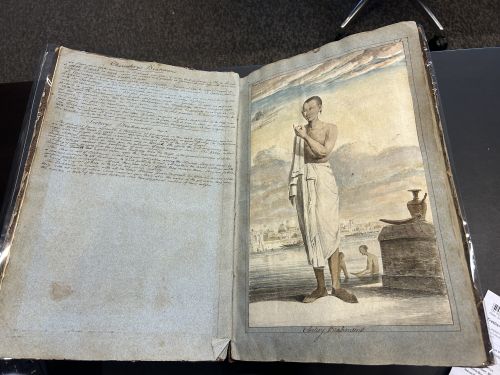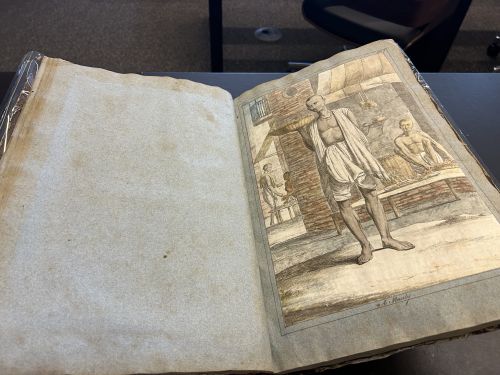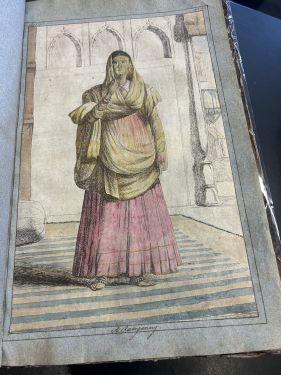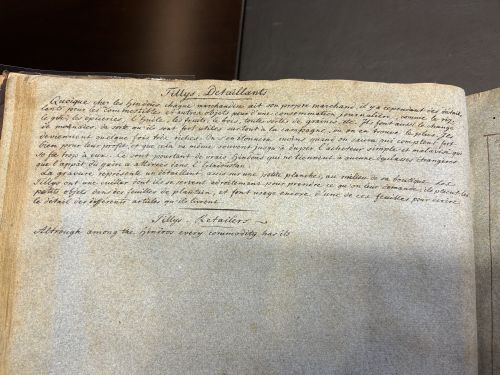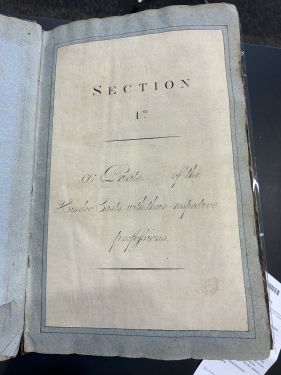Balthazar Solvyns' Etchings of Colonial India: Difference between revisions
No edit summary Tag: Manual revert |
No edit summary |
||
| (23 intermediate revisions by the same user not shown) | |||
| Line 1: | Line 1: | ||
[[File:Cover.jpg|thumb|300px|right|Marble Cover on Book.]] | |||
[https://franklin.library.upenn.edu/catalog/FRANKLIN_9924875933503681 A collection of two hundred and fifty coloured etchings descriptive of the manners, customs and dresses of the Hindoos] is a book authored by Balthazar Solvyns around 1799. The piece was created and published in Calcutta and currently resides in the University of Pennsylvania’s Kislak Center for Special Collections after it was accessioned in 1960. This book is categorized as a scrapbook and comprises 250 etchings featuring the wide variety of occupations in 18th century India that are typically accompanied by descriptive captions in both French and English. | |||
[https://franklin.library.upenn.edu/catalog/FRANKLIN_9924875933503681 A collection of two hundred and fifty coloured etchings descriptive of the manners, customs and dresses of the Hindoos] is a | |||
| Line 9: | Line 8: | ||
===Historical Context=== | ===Historical Context=== | ||
This | This book was published in Calcutta, a colonial city developed as a British settlement by the English East India Company in 1690.<ref name="Calcutta">De, T. (n.d.). About Calcutta. Retrieved April 26, 2023, from https://www.isical.ac.in/~theophys-07/calcutta.html#:~:text=Warren%20Hastings%2C%20the%20first%20Governor,moved%20from%20Murshidabad%20to%20Calcutta</ref> Not long after company rule in Calcutta was first established, the city became a pinnacle of learning, trade, arts, finance and law in the Indian subcontinent leading to its eventual position as the capital of British India in 1772.<ref name= "Calcutta"/>The geography of the land allowed Calcutta to become a prime port city for the British Empire, bringing in a wide variety of people and occupations including painters, weavers, and masons.<ref name="port">Raj, K. (2011). The historical anatomy of a contact zone: Calcutta in the eighteenth century. "The Indian Economic & Social History Review", 48(1), 55-82.</ref> | ||
The governor of Calcutta at the time, Warren Hastings, implemented a policy to provide monetary support to officials to support the study of Indian languages and cultural practices.<ref name= "port"/> This policy spearheaded the effort to amass knowledge and information about the people of the Indian subcontinent for the purposes of the British empire. | The governor of Calcutta at the time, Warren Hastings, implemented a policy to provide monetary support to officials to support the study of Indian languages and cultural practices.<ref name= "port"/> This policy spearheaded the effort to amass knowledge and information about the people of the Indian subcontinent for the purposes of the British empire. | ||
| Line 18: | Line 17: | ||
===Balthazar Solvyns=== | ===Balthazar Solvyns=== | ||
Balthazar Solvyns was one such artist based in Calcutta and focused on creating ethnographic art. Solvyns is credited with the creation of the etchings in this | Balthazar Solvyns was one such artist based in Calcutta and focused on creating ethnographic art. Solvyns is credited with the creation of the etchings in this book. He was born in Antwerp and spent time in Paris training as a marine painter.<ref name= "house"/> Resulting from political unrest in Europe, Solvyns moved to Calcutta where he began the massive project that culminated in the compilation of his 250 etchings.<ref name= "house"/> <ref name= "project"> Hardgrave, R. L. (n.d.). "The Solvyns Project". The solvyns project. Retrieved April 26, 2023, from https://www.laits.utexas.edu/solvyns-project/index.html</ref> Sources claim that he began this project in 1793 and published his etchings in 1799.<ref name= "house"/> | ||
In a December 1795 published edition of the Calcutta Gazette, Solvyns stated “the drawings of the whole collection [will be] taken partly from nature and | In a December 1795 published edition of the Calcutta Gazette, Solvyns stated “the drawings of the whole collection [will be] taken partly from nature and partly from original paintings in the possession of gentleman in India”<ref name= "house"/> indicating that he may have created his etchings by acting as a first-hand witness of daily life in India and by recreating existing paintings that featured similar content. It also remains unclear who wrote the accompanying captions to the etchings and whether Solvyns himself compiled the work in scrapbook format. | ||
===History of Costume Books and Print Collecting in Northern Europe=== | ===History of Costume Books and Print Collecting in Northern Europe=== | ||
The content of this | The content of this book is reminiscent of the costume book tradition in Europe. The costume book was born in the 16th century through inspiration from travelogs and became the primary means to feature the people of foreign lands.<ref name= "costume"> Riello, G. (2019). The world in a book: the creation of the global in sixteenth-century European costume books. "Past & Present", 242(Supplement_14), 281-317.</ref> | ||
The assemblage of this book also harkens back to the European tradition of print-collecting. Print-collecting was popularized as a form of connoisseurship during the Renaissance.<ref name= "print"> Parshall, P. (1994). Art and the theater of knowledge: the origins of print collecting in northern Europe. Harvard University "Art Museums Bulletin", 2(3), 7-36. </ref> Prints were collected from artists’ workshops and typically used for the enhancement of existing books. <ref name= "print"/> Additionally, prints created by specific publishing houses were eventually curated in albums and portfolios. <ref name= "print"/> | |||
The process of print-collecting was relied upon in the creation of this book whether by Solvyns or an anonymous collector. The work assumes a costume book-esque format with the purpose of advancing exploration of daily life in colonial India. | |||
The process of print-collecting was relied upon in the creation of this | |||
==Material Analysis== | ==Material Analysis== | ||
===Substrate and Platform=== | ===Substrate and Platform=== | ||
This | This book has been produced on blue album paper that is thin enough to contain 250 etchings. It appears as though the cursive text has been directly inscribed onto the paper while the etchings have been glued in. It is likely that the individual that compiled the album bought an initially empty album cover and proceeded to paste in the etchings and directly transcribe the captions on to the pages. | ||
The bibliographic format of this codex is folio and its length of 21 inches allows for full-length portrayals of the people presented in the etchings. The codex is rectangular in shape and the etchings span the entire length of the page. | The bibliographic format of this codex is folio and its length of 21 inches allows for full-length portrayals of the people presented in the etchings. The codex is rectangular in shape and the etchings span the entire length of the page. | ||
[[File:Title Page Solvyns.jpg|thumb|200px|left|Title Page of the Book with missing imprint piece replaced by blue strip of album paper.]] | |||
===Binding=== | ===Binding=== | ||
The | The book is bound in a manner that appears to be consistent with European binding styles of the late 18th century. The spine contains gold tooling that creates five segments. In gold tooling, there is also a condensed version of the title and author that states, “SOLVYNS’S MANNERS & CUSTOMS OF THE HINDOOS”. The cover of this codex is hardcover and has been made using red, marbled paper. Such use of gold tooling and red labeling was characteristic of the 17th and 18th century binding style known as “budget binding” as the binding methods were simple in process yet decorative. <ref name= "binding"> Michigan State University. (n.d.). 18th century: Elaboration and simplicity". MSU Libraries. Retrieved April 26, 2023, from https://lib.msu.edu/exhibits/historyofbinding/18thcentury/ </ref> | ||
[[File:Binding Solvyns.jpg|thumb|200px|right|Budget binding of book with gold tooling.]] | |||
===Navigational Features=== | ===Navigational Features=== | ||
The | The book contains a descriptive title page that contains the title of the piece, the date of publication, the location of publication, and the author. Curiously, there appears to be a missing piece of text on the title page that has been cut out and replaced with a strip of blue album paper. Digital versions of this book do not reveal what the text may have been, though it is reasonable to suggest that it may have been an imprint containing information about the publisher. There does not appear to be any indication of a patron or dedication in the book which is indicative of the fact that the Solvyns may have funded this project himself which was rare for ethnographic works at the time as they would often be dedicated to the East India Company.<ref name= "house"/> | ||
Within the | Within the book, there are section pages that serve as titles for the upcoming chapter. The sections are organized thematically to cue in the reader to the subject matter of the proceeding etchings. | ||
===Etchings=== | ===Etchings=== | ||
| Line 48: | Line 50: | ||
In each of his five sections, Solvyns or the scrapbook compiler depicts various occupations and the people of Calcutta. In Section 1, the scrapbook compiler begins with those of highest caste and orders the rest of the plates in descending order of the established social hierarchy. The same is true for later sections, though it is harder to tell whether the same social hierarchy is preserved as the sections past the first lack captions that detail what the role entailed. | In each of his five sections, Solvyns or the scrapbook compiler depicts various occupations and the people of Calcutta. In Section 1, the scrapbook compiler begins with those of highest caste and orders the rest of the plates in descending order of the established social hierarchy. The same is true for later sections, though it is harder to tell whether the same social hierarchy is preserved as the sections past the first lack captions that detail what the role entailed. | ||
<gallery mode="packed" perrow=4 heights=250px> | |||
File:Etching_with_text.jpg|Etching with text | |||
File:Etching_without_text.jpg|Etching without text | |||
File:Colorful_Etching.jpg|Colorful Etching of a Woman | |||
{...} | |||
</gallery> | |||
===Text=== | ===Text=== | ||
| Line 59: | Line 68: | ||
It is also important to note that many of the captions are written with a respectful tone and attitude, particularly when describing those deemed to be of “lower rank”. For example, in describing the role of a milkman, the writer describes the agility with which he balances the milk jugs. Similarly, when describing a writer, the caption states that they “Write very well, even the languages of the foreign nations”. | It is also important to note that many of the captions are written with a respectful tone and attitude, particularly when describing those deemed to be of “lower rank”. For example, in describing the role of a milkman, the writer describes the agility with which he balances the milk jugs. Similarly, when describing a writer, the caption states that they “Write very well, even the languages of the foreign nations”. | ||
<gallery mode="packed" perrow=4 heights=250px> | |||
File:Sroterys_Brahmans_text.jpg|Text describing "Sroterys Brahmans" with words crossed out and underlined. | |||
File:Incomplete_English_Translation.jpg|French caption on top with an incomplete English translation below. | |||
File:Section_1_Title.jpg|Printed Section 1 Title | |||
{...} | |||
</gallery> | |||
==Significance== | ==Significance== | ||
| Line 64: | Line 80: | ||
Sikhs are a religious community in India that typically reside in the region of Punjab, a state that is many kilometers away from the state of Bengal where Calcutta is located. <ref name= "Sikh"/> | Sikhs are a religious community in India that typically reside in the region of Punjab, a state that is many kilometers away from the state of Bengal where Calcutta is located. <ref name= "Sikh"/> | ||
Though this | Though this book has significant meaning today, it was not thought to hold the same significance amongst European audiences of the 18th century. In fact, Solvyns work was deemed to be a financial failure which is often chalked up to the fact that audiences considered his etchings to be too dull.<ref name= "house"/> It is evident that the work intrigued some groups of people as the well-known printmakers, Edward and William Orme, pirated Solvyns’ original work and republished it.<ref name= "house"/> In the republished version, Orme further darkened the skin of the figures in the etchings and removed etchings containing portrayals of Hindu rituals.<ref name= "house"/> In doing so, they created a collection of 60 etchings representing trade, transport, and household servants, topics that particularly appealed to the British metropolitan. The pirated version ended up being a financial success.<ref name= "house"/> | ||
Even though Solvyns’ version failed financially, his work is praised for being the harbinger of the “Company School” genre of paintings in the 18th and 19th centuries.<ref name= "house"/> In this genre of art, Indian artists would create art tailored to the European gaze by creating romanticized views of the landscape and impressive images of the people.<ref name= "house"/> | Even though Solvyns’ version failed financially, his work is praised for being the harbinger of the “Company School” genre of paintings in the 18th and 19th centuries.<ref name= "house"/> In this genre of art, Indian artists would create art tailored to the European gaze by creating romanticized views of the landscape and impressive images of the people.<ref name= "house"/> | ||
Latest revision as of 16:06, 29 April 2023
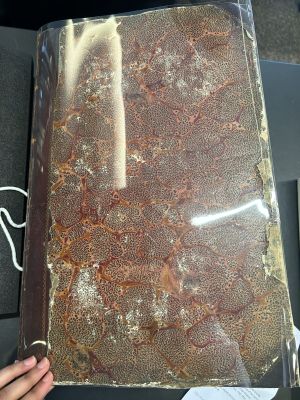
A collection of two hundred and fifty coloured etchings descriptive of the manners, customs and dresses of the Hindoos is a book authored by Balthazar Solvyns around 1799. The piece was created and published in Calcutta and currently resides in the University of Pennsylvania’s Kislak Center for Special Collections after it was accessioned in 1960. This book is categorized as a scrapbook and comprises 250 etchings featuring the wide variety of occupations in 18th century India that are typically accompanied by descriptive captions in both French and English.
Background
Historical Context
This book was published in Calcutta, a colonial city developed as a British settlement by the English East India Company in 1690.[1] Not long after company rule in Calcutta was first established, the city became a pinnacle of learning, trade, arts, finance and law in the Indian subcontinent leading to its eventual position as the capital of British India in 1772.[1]The geography of the land allowed Calcutta to become a prime port city for the British Empire, bringing in a wide variety of people and occupations including painters, weavers, and masons.[2]
The governor of Calcutta at the time, Warren Hastings, implemented a policy to provide monetary support to officials to support the study of Indian languages and cultural practices.[2] This policy spearheaded the effort to amass knowledge and information about the people of the Indian subcontinent for the purposes of the British empire.
The East India Company had provided the infrastructure necessary to support the storage of such information by establishing printing presses in Calcutta. Ultimately, by 1800, there were roughly 40 printing presses in Calcutta that also featured type fonts in the Devanagari and Bengali scripts. [2] The widespread establishment of printing presses in Calcutta brought on the rise of libraries and bookshops for storage of European books as well as of manuscripts created in Calcutta and the wider state of Bengal.[2] Ultimately, this set Calcutta up to become “the birthplace of large-scale printing in the Subcontinent” and a flourishing cultural center.[2]
In 1785, many wealthy governors, bankers, and merchants left Calcutta to move back to Europe and in the process left many artists with little opportunity to obtain commissions.[3] As a result, the artistic community collectively had to explore art forms outside of portraiture and began associating themselves with establishments known as Houses of Agency.[3] Houses of agency supported the artistic community by selling artist prints at public auctions.[3] At the time, ethnographic content was popular amongst consumers which led to much of the artistic community to shift to producing such art.[3]
Balthazar Solvyns
Balthazar Solvyns was one such artist based in Calcutta and focused on creating ethnographic art. Solvyns is credited with the creation of the etchings in this book. He was born in Antwerp and spent time in Paris training as a marine painter.[3] Resulting from political unrest in Europe, Solvyns moved to Calcutta where he began the massive project that culminated in the compilation of his 250 etchings.[3] [4] Sources claim that he began this project in 1793 and published his etchings in 1799.[3]
In a December 1795 published edition of the Calcutta Gazette, Solvyns stated “the drawings of the whole collection [will be] taken partly from nature and partly from original paintings in the possession of gentleman in India”[3] indicating that he may have created his etchings by acting as a first-hand witness of daily life in India and by recreating existing paintings that featured similar content. It also remains unclear who wrote the accompanying captions to the etchings and whether Solvyns himself compiled the work in scrapbook format.
History of Costume Books and Print Collecting in Northern Europe
The content of this book is reminiscent of the costume book tradition in Europe. The costume book was born in the 16th century through inspiration from travelogs and became the primary means to feature the people of foreign lands.[5]
The assemblage of this book also harkens back to the European tradition of print-collecting. Print-collecting was popularized as a form of connoisseurship during the Renaissance.[6] Prints were collected from artists’ workshops and typically used for the enhancement of existing books. [6] Additionally, prints created by specific publishing houses were eventually curated in albums and portfolios. [6]
The process of print-collecting was relied upon in the creation of this book whether by Solvyns or an anonymous collector. The work assumes a costume book-esque format with the purpose of advancing exploration of daily life in colonial India.
Material Analysis
Substrate and Platform
This book has been produced on blue album paper that is thin enough to contain 250 etchings. It appears as though the cursive text has been directly inscribed onto the paper while the etchings have been glued in. It is likely that the individual that compiled the album bought an initially empty album cover and proceeded to paste in the etchings and directly transcribe the captions on to the pages.
The bibliographic format of this codex is folio and its length of 21 inches allows for full-length portrayals of the people presented in the etchings. The codex is rectangular in shape and the etchings span the entire length of the page.

Binding
The book is bound in a manner that appears to be consistent with European binding styles of the late 18th century. The spine contains gold tooling that creates five segments. In gold tooling, there is also a condensed version of the title and author that states, “SOLVYNS’S MANNERS & CUSTOMS OF THE HINDOOS”. The cover of this codex is hardcover and has been made using red, marbled paper. Such use of gold tooling and red labeling was characteristic of the 17th and 18th century binding style known as “budget binding” as the binding methods were simple in process yet decorative. [7]
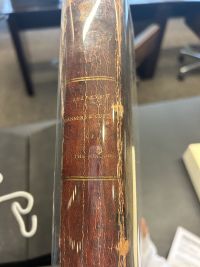
The book contains a descriptive title page that contains the title of the piece, the date of publication, the location of publication, and the author. Curiously, there appears to be a missing piece of text on the title page that has been cut out and replaced with a strip of blue album paper. Digital versions of this book do not reveal what the text may have been, though it is reasonable to suggest that it may have been an imprint containing information about the publisher. There does not appear to be any indication of a patron or dedication in the book which is indicative of the fact that the Solvyns may have funded this project himself which was rare for ethnographic works at the time as they would often be dedicated to the East India Company.[3]
Within the book, there are section pages that serve as titles for the upcoming chapter. The sections are organized thematically to cue in the reader to the subject matter of the proceeding etchings.
Etchings
The etchings are massive as they span the entire length of the book on the recto side and are always colored. Each of the 250 etchings include a title that often describes the occupation being displayed in the etching, the section number in the top left corner, and the image number within that section in the top right corner. In terms of content, the etchings contain a main character of sorts in the foreground with additional individuals, tools, and locations depicted in the background. The figures in the etchings appear to be tall and grandiose with respect to the background which draws the audience into the subject of the image. The figures usually also adorn a more somber or non-expressive facial expression.
In each of his five sections, Solvyns or the scrapbook compiler depicts various occupations and the people of Calcutta. In Section 1, the scrapbook compiler begins with those of highest caste and orders the rest of the plates in descending order of the established social hierarchy. The same is true for later sections, though it is harder to tell whether the same social hierarchy is preserved as the sections past the first lack captions that detail what the role entailed.
-
Etching with text
-
Etching without text
-
Colorful Etching of a Woman
Text
The primary text in this book are captions to the etchings that have been directly handwritten in cursive on the verso side of the album paper. The captions are written in both French and English, with the French translation preceding the English one. The captions begin with an underlined title that corresponds with the etching title to describe the occupation being presented.
In certain circumstances, only the French caption is complete while the English translation has been left incomplete. This, coupled with the fact that the French translation comes before the English one, may indicate that the primary audience of the book was French. Further, only section one contains captions of the etchings. Afterwards, the etchings remain titled but the verso side is just blank album paper. This leads to a wide variety of explanatory speculations including that Solvyns in his time as a journeyman artist may not have been able to acquire enough information about the occupational details of the person or that he or the scrapbook compiler did not feel it necessary to fully describe the occupations in the later half of the book or even that the publisher was in a rush to publish which resulted in incomplete translations and captions.
Within the caption text, one can also find semantic writing marks. Hindi and Bengali words and phrases are frequently underlined, likely to draw attention to the use of specific vocabulary. This is indicative of the fact that the book likely intended to serve as an Encyclopedia. There are also situations where words have been crossed out and rewritten or even replaced by other words. Interestingly, there are usually disparities in which words have been underlined in the French and English translations.
In terms of content of the text, the captions serve as intricately detailed descriptions of the etchings. They start out by stating the occupation of the individual portrayed and then migrate into discussing broader topics such as the tools in the background and the specific type of oil a confectioner uses to create a pastry. The language of the captions also make it seem like the transcriber was present when the etchings were being created as many of the text say things like “he spent quite a lot of time with the learned” and “we have seen”. The use of the third person may suggest that a transcriber other than Solvyns was present to detail the observations and discussions during journeys across Calcutta.
It is also important to note that many of the captions are written with a respectful tone and attitude, particularly when describing those deemed to be of “lower rank”. For example, in describing the role of a milkman, the writer describes the agility with which he balances the milk jugs. Similarly, when describing a writer, the caption states that they “Write very well, even the languages of the foreign nations”.
-
Text describing "Sroterys Brahmans" with words crossed out and underlined.
-
French caption on top with an incomplete English translation below.
-
Printed Section 1 Title
Significance
This compilation of 250 etchings is often touted by scholars to be “the first great ethnographic survey of life in Bengal”.[4] Solvyns work is unique as he provides a systematized depiction of the caste system of India and provides first hand accounts that allow modern day historians to better understand colonial India.[4] Scholars state that Solvyns’ work was the first in the world to depict a published image of a “Khalsa Sikh” by a European. [8] Sikhs are a religious community in India that typically reside in the region of Punjab, a state that is many kilometers away from the state of Bengal where Calcutta is located. [8]
Though this book has significant meaning today, it was not thought to hold the same significance amongst European audiences of the 18th century. In fact, Solvyns work was deemed to be a financial failure which is often chalked up to the fact that audiences considered his etchings to be too dull.[3] It is evident that the work intrigued some groups of people as the well-known printmakers, Edward and William Orme, pirated Solvyns’ original work and republished it.[3] In the republished version, Orme further darkened the skin of the figures in the etchings and removed etchings containing portrayals of Hindu rituals.[3] In doing so, they created a collection of 60 etchings representing trade, transport, and household servants, topics that particularly appealed to the British metropolitan. The pirated version ended up being a financial success.[3]
Even though Solvyns’ version failed financially, his work is praised for being the harbinger of the “Company School” genre of paintings in the 18th and 19th centuries.[3] In this genre of art, Indian artists would create art tailored to the European gaze by creating romanticized views of the landscape and impressive images of the people.[3]
Although much has been left to speculation with regards to the creator(s) of this book and limited knowledge about its use and circulation, it has evident meaning in its source as a comprehensive survey of life in British India. It is novel in its inclusion of certain subject matter and respectful of the way it addresses Indian customs and people. Solvyns’ work is appreciable in the manner it chooses to use the colonial gaze as a means to accurately articulate the people and customs of India, serving as a valuable source of information for contemporary readers as well as the audience of the 18th century.
Bibliography
- ↑ 1.0 1.1 De, T. (n.d.). About Calcutta. Retrieved April 26, 2023, from https://www.isical.ac.in/~theophys-07/calcutta.html#:~:text=Warren%20Hastings%2C%20the%20first%20Governor,moved%20from%20Murshidabad%20to%20Calcutta
- ↑ 2.0 2.1 2.2 2.3 2.4 Raj, K. (2011). The historical anatomy of a contact zone: Calcutta in the eighteenth century. "The Indian Economic & Social History Review", 48(1), 55-82.
- ↑ 3.00 3.01 3.02 3.03 3.04 3.05 3.06 3.07 3.08 3.09 3.10 3.11 3.12 3.13 3.14 Eaton, N. (2014). Virtual witnessing? Balthazar Solvyns and the navigation of precision, c. 1790–1840. "Journal of Historical Geography", 43, 49-59.
- ↑ 4.0 4.1 4.2 Hardgrave, R. L. (n.d.). "The Solvyns Project". The solvyns project. Retrieved April 26, 2023, from https://www.laits.utexas.edu/solvyns-project/index.html
- ↑ Riello, G. (2019). The world in a book: the creation of the global in sixteenth-century European costume books. "Past & Present", 242(Supplement_14), 281-317.
- ↑ 6.0 6.1 6.2 Parshall, P. (1994). Art and the theater of knowledge: the origins of print collecting in northern Europe. Harvard University "Art Museums Bulletin", 2(3), 7-36.
- ↑ Michigan State University. (n.d.). 18th century: Elaboration and simplicity". MSU Libraries. Retrieved April 26, 2023, from https://lib.msu.edu/exhibits/historyofbinding/18thcentury/
- ↑ 8.0 8.1 Singh Madra, A., & Singh, P. (2004). An Artist’s Impressions of the Sikhs, Balt Solvyns, 1796. "“Sicques, Tigers, or Thieves”: Eyewitness Accounts of the Sikhs" (1606–1809), 177-181.
